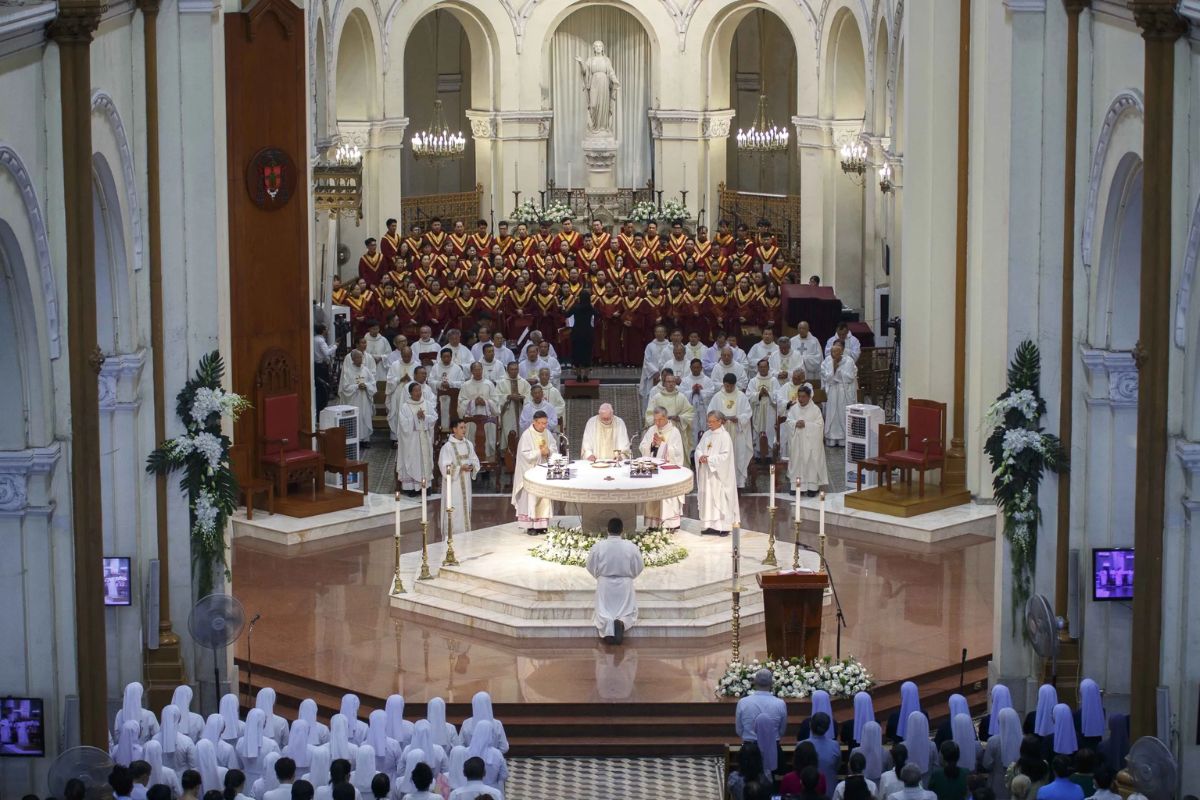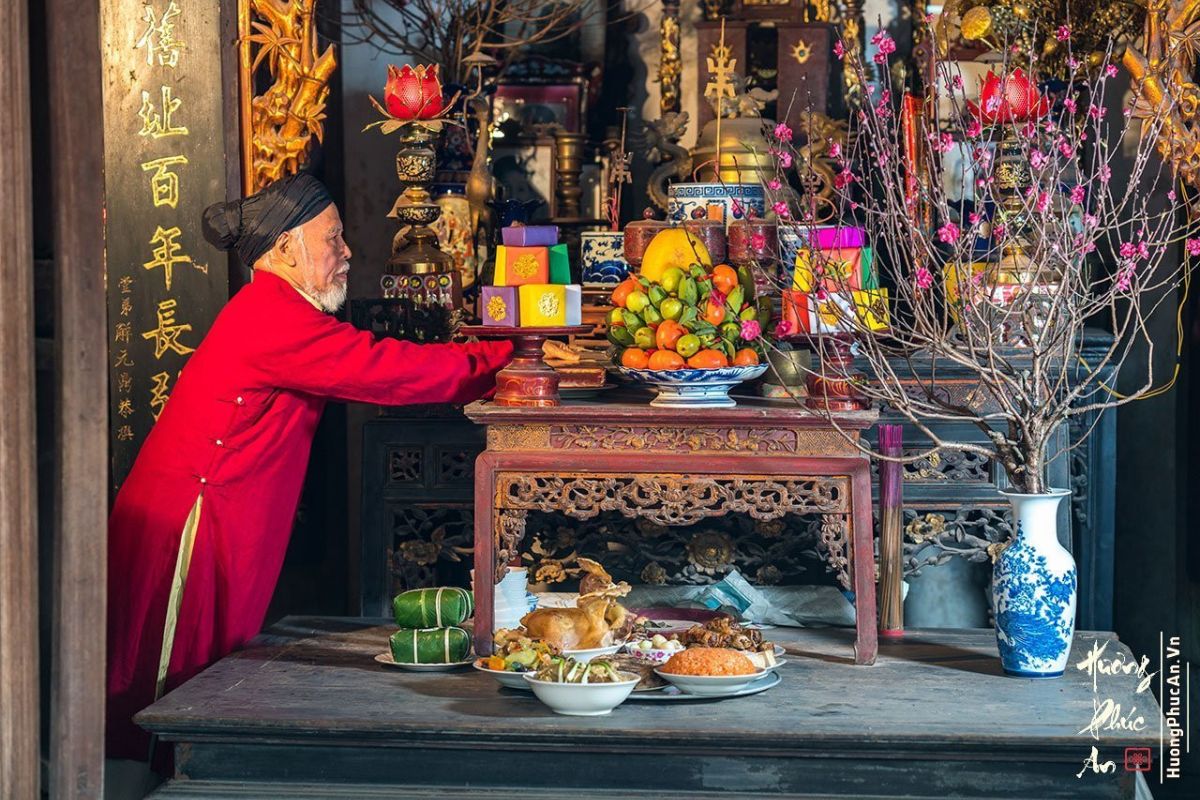TABLE OF CONTENT
The religious practices in Vietnam are a blend of indigenous traditions, major world religions, and spiritual practices that have been evolving for centuries. Many Vietnamese people view religion as a means of fostering relationships with their family, ancestors, and the community in addition to being a matter of faith. If you’re curious about what are Vietnamese people’s religion, Asia Encounter will guide you through the top five religions in the country and the popular custom of ancestor worship. We’ll also explore some of Vietnam’s most famous religious destinations and give you insight into the spiritual fabric of this historical country.

Background of Vietnamese religion
Vietnam has a long history of religious diversity and tolerance, with various belief systems coexisting peacefully for centuries. Vietnam’s religious landscape is typified by a synthesis of imported religions, native beliefs, and syncretic behaviors that have developed over time. This distinctive blend is a reflection of both the nation’s rich spiritual traditions and its historical contacts with neighboring cultures.
While major religions like Buddhism and Catholicism are prevalent, many Vietnamese people also follow indigenous beliefs that are still deeply ingrained in their daily lives, such as ancestor worship. While some people identify as Buddhists but continue to worship their ancestors, others may have no formal religion at all or multiple religions.
What are Vietnamese people’s religion? Top 5 major religions in Vietnam
Buddhism
What are Vietnamese people’s religion? For a large portion of the population, the answer is Buddhism. Buddhism has been practiced for almost 2,000 years, making it the most popular religion in Vietnam. The majority of Vietnamese Buddhists now follow the Mahayana school, which places a strong emphasis on compassion, wisdom, and enlightenment. Buddhism was brought to Vietnam through China and India.

Buddhist temples and pagodas can be found all over the country, from the towering Bai Dinh Pagoda in the north to the serene Giac Lam Pagoda in the south. These temples not only serve as places of worship but also as cultural landmarks that offer insight into Vietnam’s history and architecture.
Buddhism has deeply influenced Vietnamese art, architecture, and literature. Many of the country’s most iconic landmarks are Buddhist temples and pagodas, such as the One Pillar Pagoda in Hanoi and the Thien Mu Pagoda in Hue.
Catholicism
European missionaries introduced Catholicism to Vietnam in the sixteenth century, and the French colonial era was crucial to its growth. With almost 7 million Catholics, mainly living in the country’s south and center, Vietnam now boasts the second-largest Catholic population in Southeast Asia.
Vietnamese Catholicism is intriguing because of the way it combines native rituals with orthodox Christian activities. For instance, ancestor worship is still practiced by a large number of Vietnamese Catholics. Two notable examples of French colonial architecture that double as important sites of religion are the magnificent Notre Dame Basilica in Ho Chi Minh City and St. Joseph’s Cathedral in Hanoi.

Protestantism
Protestantism arrived in Vietnam much later, only becoming established in the early 20th century through missionaries from Europe and the United States. Protestantism has progressively increased, even if it is still smaller than Catholicism, particularly among ethnic minority communities in the Central Highlands.
Vietnamese Protestant churches are renowned for their commitment to the local community. Churchgoers often get together for social events, worship sessions, and Bible studies. Protestantism also supports charity endeavors that assist in giving underprivileged populations access to social, medical, and educational resources. While you won’t find too many grand Protestant cathedrals in Vietnam, these communities contribute their unique religious styles to Vietnam’s diverse religious landscape.
Caodaism
Originating in Vietnam in the 1920s, caodaism is a distinct syncretic religion. It combines elements of Buddhism, Christianity, Taoism, Confucianism, and indigenous Vietnamese beliefs. What are Vietnamese people’s religion? For followers of Caodaism, their faith represents a modern synthesis of various spiritual traditions.
The most significant site for this religion is the Caodai Holy See in Tay Ninh Province, a colorful and grand temple complex that serves as both a spiritual and tourist destination. The architecture of the Holy See reflects the religion’s eclectic mix of influences, making it a must-see for visitors curious about Vietnam’s spiritual diversity.

Hoahaoism
Another indigenous Vietnamese religion that arose in the 20th century is called Hoahaoism, or Hoa Hao Buddhism. It is a Buddhist reform movement with aspects of traditional Vietnamese beliefs, founded in 1939 by Huynh Phu So. While it shares some of Buddhism’s key tenets, Hoahaoism places less emphasis on temple worship and more on personal practice and charity.
Hoahaoism has millions of followers, particularly in the Mekong Delta region. Followers are known for their charitable work and deep commitment to their communities, and religion plays an important role in the spiritual and social life of the Mekong Delta region.
Ancestor worship – a popular belief in Vietnam
To fully answer the question what are Vietnamese people’s religion, we cannot fail to mention the tradition of ancestor worship. As one of the most widespread spiritual practices in Vietnam, ancestor worship is not exactly a religion on its own, but it’s a massive part of Vietnamese spiritual life. The belief that the spirits of one’s ancestors continue to influence the living has shaped the way many Vietnamese people view the world.

Families often maintain altars in their homes where they make offerings of food, incense, and prayers to their ancestors, especially during important holidays like the Lunar New Year (Tet). This practice is not exclusive to any single religion, and even those who follow Buddhism, Catholicism, or other faiths often incorporate ancestor worship into their religious practices.
Must-see religious destinations in Vietnam
After discussing the topic of “what are the religions of the Vietnamese people?” let’s take a closer look at some of the nation’s most breathtakingly beautiful spiritual locations. There are so many wonderful religious sites in Vietnam that they will amaze you. Here are a few that you must not overlook:
Perfume Pagoda (Chua Huong)
Located in the Huong Tich mountains, this vast complex of Buddhist temples and shrines is a pilgrimage site like no other. To reach the main cave temple, you’ll take a scenic boat ride followed by a hike (or cable car ride) up the mountain.
One Pillar Pagoda
This iconic Hanoi landmark was built in the 11th century and symbolizes a lotus flower rising from the water. Despite its small size, it’s one of Vietnam’s most important temples and a masterpiece of traditional architecture.

Bai Dinh Pagoda
As the largest Buddhist structure in Vietnam, Bai Dinh Pagoda is impressive in both size and beauty. The complex has a 13-story pagoda, many temples, and stupas. The enormous bronze statues of Buddha are very magnificent.
Notre-Dame Cathedral Basilica of Saigon
This stunning example of French colonial architecture stands out in bustling Ho Chi Minh City. Its distinctive red brick facade and twin bell towers make it one of the city’s most recognizable landmarks.
My Son Sanctuary
This UNESCO World Heritage site highlights the rich religious heritage of Vietnam, even though it does not reflect the country’s current religions. A glimpse into a different age of Vietnamese spirituality can be found in the ancient Hindu temples of the Champa culture.
Cao Dai Holy See
The Tay Ninh province Caodaism headquarters is a riot of color and symbols. The temple is a singular architectural wonder because of the way it combines elements from many religions. For a truly unique experience, try to schedule your visit during one of the daily prayer sessions.
—
So have you answered the question what are Vietnamese people’s religion? As we’ve seen, it’s a complex tapestry of beliefs and practices that reflect the country’s rich cultural heritage. Next time if you’re planning a trip to Vietnam, consider adding some of these spiritual spots to your itinerary. You might just find that in seeking to understand what Vietnamese people’s religion is, you’ll discover a whole new side of this incredible country.
To better understand religion when visiting Vietnam, choosing travel agencies with a team of knowledgeable tour guides like Asia Encounter is a wise decision. You’ll get an insider’s view of Vietnam’s major religious landmarks and gain a deeper understanding of the local customs and beliefs that make this country so special. Check out Asia Encounter’s 16 Vietnam heritage sites tour or customize your own itinerary with us!




